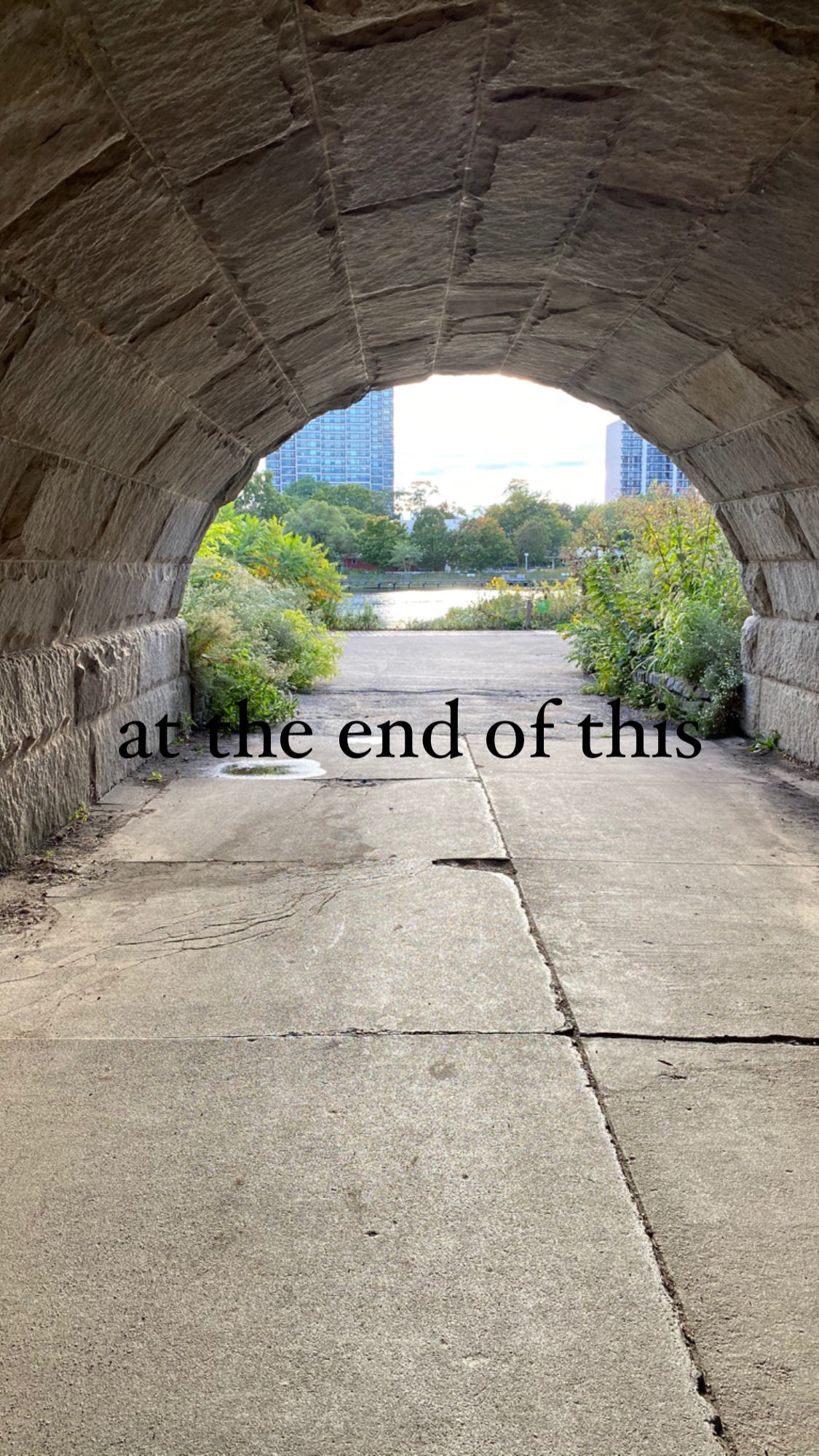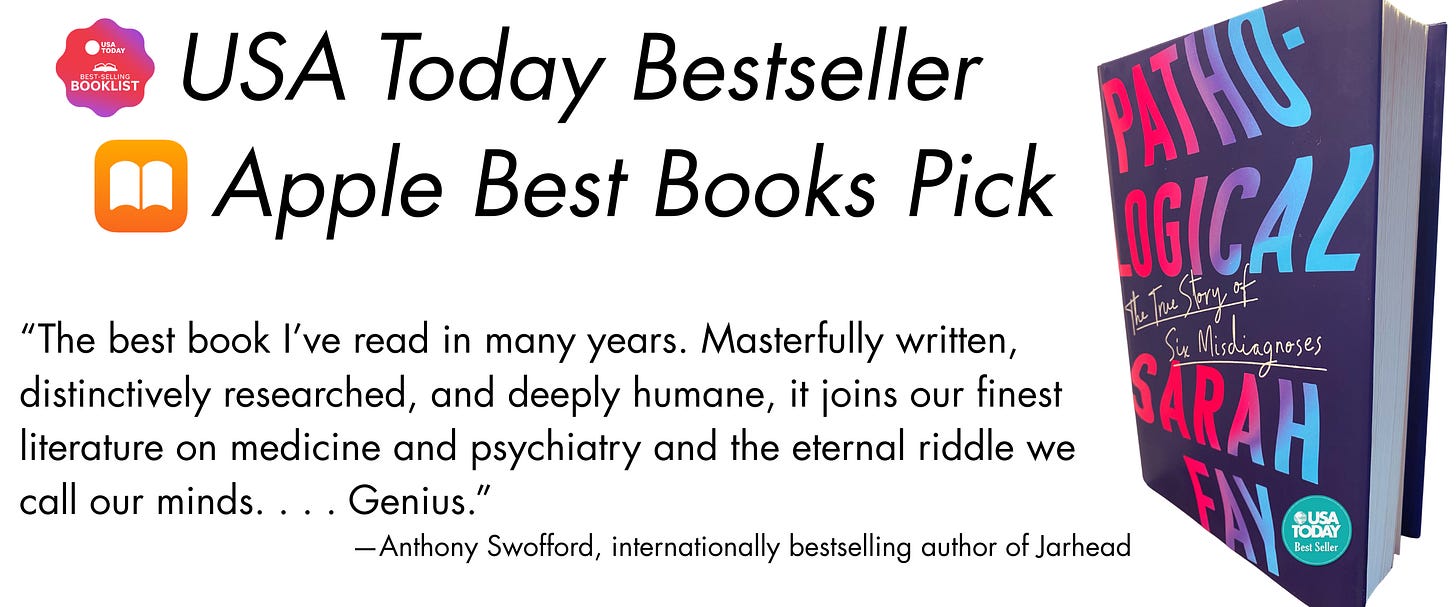Of course, there is no recipe for mental health—not if we think of mental health as a blissful or even generally neutral state.
I know because, having fully recovered from twenty-five years of serious mental illness, I still experience depression and anxiety and panic and all (or most) of the negative emotions.
Today, my body aches. It’s the kind of bone-ache that comes with depression, along with hollowness and irritability.
Bracing against it makes it worse.
Speaking to it doesn’t make it disappear, but it lessens and, of course, makes me feel less alone. Sarah, I say to myself, you’ve got this. Nothing has gone wrong. You’re okay.
And it “works,” meaning, it normalizes it.
Let me explain how I went from being chronically suicidal for five years to this.
Five years ago, I read
’s Chatter: The Voice in Our Heads, Why It Matters, and How to Harness It, which should be required reading for all humans everywhere, and discovered this skill’s name: self-talk. It’s what it sounds like: positive statements we intentionally say to ourselves, often amidst a sea of irrational, negative, unintentional thoughts.But positive self-talk isn’t toxic positivity—because negative self-talk is automatic and will outwit toxic positivity every time. Our internal narrator is onto us before the words I’m enough or I live in abundance can form in our minds. It’s a coping strategy to deal with tension, stress, and mental and emotional pain.
It can act like an inner enemy. As the former Nightline anchor turned bestselling author and award-winning podcaster
put it: “The voice inside my head is an asshole.” Mine has always been a really mean fifth-grade girl whose bullying knows no bounds.Supposedly, most negative self-talk stems from a single, universal fear: not being good enough. But I think it’s more about our brains just trying to keep us alive and being terribly misguided. Our inner monologue is evolutionarily designed to keep us alive, not make us happy. It just wants us to conserve energy, seek pleasure, and avoid pain.
The machinations of our inner bully are something of a mystery. The subvocalization results from a phonological loop in the brain, including the inner ear. The research psychologist Russell Hurlburt, who has been studying auditory inner experiences since the 1970s, found that not everyone has an inner voice; some people think purely in images. Of those who do experience internal speech, many don’t know what it’s saying. Most people perceive their inner voice as sounding like their own.
For two decades, sports psychology has been studying positive self-talk and its effect on athletes’ performance. Positive self-talk is in the second or third person: You’re okay or Sarah is okay. Researchers found that the key to self-talk is the use of the second person: You’ve got this. Focus. Using your own name can also help: Sarah, focus. The second-person voice (you’ve got this) is like having a personal therapist on call.
It isn’t just for athletes. A 2020 study showed that those who used positive self-talk had less anxiety and OCD symptoms during the pandemic. Students who participated in a 2019 study experienced less performance anxiety if they recited affirming statements before a performance.
Reducing my negative self-talk and creating positive self-talk slowly became the core of my recovery. No more vicious critic (I suck), only coach (you can do this). I invented a supportive voice (you) I’d never heard before, one that became essential to my recovery and staying well.
Another thought-management skill that virtually or literally saves my life after being chronically suicidal for five years comes from brain-dumping on a piece of paper.
Of course, writing is one of the most powerful “wellness strategies” I find. First, it’s just about distancing myself from my thoughts by writing them down and throwing them away.
A study found that people who wrote down their thoughts and threw away the piece of paper cast off the thoughts themselves. Those who wrote down their thoughts and carried them around had the opposite effect. Essentially, we “tag [our] thoughts—as trash or as worthy of protection.” Mindfulness and seeing our thoughts as clouds drifting by aren’t enough; we have to actually write them down, crumple the paper, and discard the thoughts that might otherwise stay with us, influencing our decisions and actions or inaction.
The writing-health connection started to be explored in the 1970s and 1980s and is most often associated with the psychologist James Pennebaker. He wanted to see how keeping a traumatic secret rather than writing about it affected both physical and mental health.
More recently, studies looking at the effects of writing across diverse populations have shown its effects. Writing about your difficulties can result in better grades, fewer missed days of work, and a better chance of getting a job after being laid off. For some, it means improved immune and hormonal dysfunction, less stress, and fewer physician visits. A 2011 study published in Science found that writing down worries before an exam alleviated anxiety and improved performance. A 2006 study showed that writing down thoughts can stop you from brooding and ease depression.
That only gets me so far. I’m a hard case. I’d tried other therapeutic techniques that rely on writing to regulate thoughts and emotions, but Cognitive Behavioral Therapy (CBT) and the myriad other modalities given to me in various hospitalization programs (DBT, ACT) never worked.
I found a life coach named Brooke Castillo who came up with a modality called The Model. Some people see it as the same as CBT—seeing that our thoughts create our feelings, which create our actions, which create our results—but it’s not. It sees our thoughts through an evolutionary lens.
For example, I sit at my desk, take a pad of paper and a pen, and do it. I write down my thoughts in a list. They’re random, occasionally mean, and uniformly negative—full of self-pity and self-hatred: This is awful, I’m going to get sick again, I’m so stupid, I hate this, I’m in trouble, I’m not doing this right, and on and on to the bottom of the page. When I go back through the list with evolutionary psychiatry in mind, I see most of them differently. This is awful, I’m going to get sick again, I’m in trouble, and I’m not doing this right are alarms sent by a brain—my brain—on the lookout for danger.
Thoughts aren’t evil. They aren’t from some dark place, as Sigmund Freud wanted us to believe. My fifth-grade bully is actually trying to help, not beat me up. Thoughts are the brain’s overly vigilant way of trying to keep us alive in an environment where such extreme vigilance typically isn’t required. They’re just my primitive instincts gone awry.
Within a week, every morning, I was writing down my thoughts and doing The Model. Soon, I was doing it at breakfast, lunch, and dinner.
Then I try gratitude.
I’d forced and faked gratitude before—on Thanksgiving, in yoga classes, upon receiving gifts—but it felt disingenuous, even a little deceitful. Gratitude can have a punitive ring to it: You better be grateful. Or too rosy. Or manipulative—I’m doing this to get that.
And the science doesn’t back it up. Although some authors claim that the research on gratitude points to its positive effects, the science of gratitude is still a nascent field. Even the University of California-Berkeley’s Greater Good Science Center, the country’s gratitude hub, readily admits that gratitude studies haven’t, for the most part, been replicable, meaning they’re more theory than proof.
Part of the problem is that researchers can’t agree on what gratitude is. Robert Emmons, professor of psychology at the University of California-Davis and reigning authority on gratitude, wrote, “Gratitude has been conceptualized as an emotion, a virtue, a moral sentiment, a motive, a coping response, a skill, and an attitude. It is all of these and more.” Gratitude depends on the person experiencing it and the context, but Emmons and his colleague Michael McCullough define it as “recognizing that one has obtained a positive outcome” and “recognizing that there is an external source for this positive outcome.” The source is often thought of as a benefactor, but it doesn’t have to be a person; often, it’s God, the universe, fate, etc.
Checklists and scales try to measure gratitude. The Greater Good Science Center’s Gratitude Adjective Checklist asks people to gauge how much they’ve felt the emotion of gratitude on a scale of one to five. The Transpersonal Gratitude Scale measures the more ethereal aspects of gratitude, like being grateful just for being alive. There are others, but the most telling is the Gratitude Questionnaire-6:
Write a number beside each statement to indicate how much you agree with it.
1 = strongly disagree
2 = disagree
3 = slightly disagree
4 = neutral
5 = slightly agree
6 = agree
7 = strongly agree
I have so much in life to be thankful for.
If I had to list everything that I felt grateful for, it would be a very long list.
When I look at the world, I don’t see much to be grateful for.
I am grateful to a wide variety of people.
As I get older, I find myself more able to appreciate the people, events, and situations that have been part of my life history.
Long amounts of time can go by before I feel grateful to something or someone.
Does anyone really get a perfect score? Are they grateful in all the right ways and never disgruntled? It’s not that the statements determining positive levels of gratitude require Mother-Teresa thankfulness. But there’s something inhuman about someone who’s 100 percent grateful. (Even she wrote about how she wasn’t grateful all the time.)
Gratitude emerges in different ways. You can have a grateful disposition, which means your baseline is one of gratitude. You can be in a grateful mood, which is more transient. Experiencing the emotion of gratitude is typically short-lived and in response to an event.
Evolutionarily speaking, gratitude is a mercenary act, something we and animals do to get something. A parrot gives one of his seeds to his brother parrot, so his brother will do the same later. If you send that thank-you note, your aunt will send money on your next birthday, too.
Still, I did the whole gratitude-journal thing. I lay in bed, put my pen to the page, and waited for gratitude to flood through me. Images of gratitude websites and pithy social media posts flashed through my mind.
All I had to do was write three things I was grateful for. What was wrong with me? Why couldn’t I simmer with thanks?
My eyelids started to droop. I fell in and out of sleep.
Tony Robbins (and I’m sure a million other people) have said that it’s impossible to be angry, anxious, sad, etc. and grateful at the same time.
Lamely but genuinely, I scribbled walking, fresh air, Dad, and turned out the light.
The best way to support my work is to purchase a copy of my national bestselling memoir Pathological, hailed by The New York Times as “a fiery manifesto of a memoir.” Pathological traces how we’ve come to believe that ordinary emotions are mental disorders and the twenty-five years I spent in the mental health system believing that psychiatric diagnoses are valid and reliable, which they’re not. If you’ve already purchased a copy, thank you! You can gift a copy to a friend, your local library, or your favorite used bookstore.







95% of all health problems start with what people are putting in their mouths...or not putting what our Creator intended for them to eat. If you don't feed your body right, your brain suffers too. The wrong foods can lead to depression and not eating enough can contribute to mental problems. The Recipe for perfect mentally and physically health begins with eating as our intended ...enough natural unprocessed foods. Since our soil does not contain the nutrients it should...supplements are most important, too. The brain needs the right nourishment in order to be healthy. I speak from experience...not from something I have read in a book! I am mentally and physically healthier going on 92 than I was in my 20s and 30s. I had to learn how to eat!!
I find myself genuinely grateful on an involuntary basis, not unlike the way Proust's memory of his childhood is summoned unexpectedly by the taste and smell of the Madeleine dipped in the tisane.